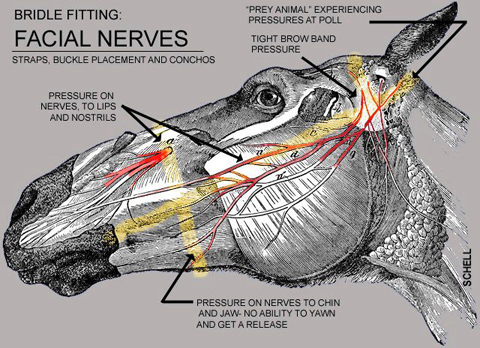
Thanks to Mindy Bower for finding this
By Caroline Larrouilh
From the very interesting Manolo Mendez Dressage website.
This is something Manolo is quite fanatical about, always adjusting nosebands, flashes, browbands and making sure the buckles do not push into delicate structures or the poll strap does not push against the horse’s ears (and of course checking bit fit).
A quick look at what cranial nerves DO reveal how important their well being is and why properly fitted tack is paramount. There are twelve pairs of cranial nerves. They have a role in:
Balance
Heart rate (sensory and motor control of viscera including heart, lungs, and bowel)
Hearing
Smell
Vision
Eye movement
Neck muscles that move the head
Sensation from the face
Motor to the muscles for biting, chewing
Facial expression
Taste from the anterior 2/3rds of the tonque
Taste from the posterior 1/3rd of the tonque
Tearing (lacrimal gland)
Salivation from the parotid gland as well as not from the parotid gland (different nerves)
Sensation and some motor to the pharynx
Swallowing (motor to the muscles of the soft palate, pharynx and larynx)
Vocalization (motor to the muscles of the soft palate, pharynx and larynx)
gastrointestinal peristalsis
Tongue movement
Our friend Diane Schell created this useful illustration showing the 12 pairs of cranial nerves and where they are in relationship to bridles potential pressure point.There is an important nerve Diane did not highlight in red. It comes out on the side of the lower jaw. It is a general sensory nerve for the skin of chin and lower lip.
Veterinarian Massimo Da Re followed up with additional insights on cranial nerves, the brain and limbic system:
The head of all vertebrates is one of the most important parts for the life of the individual: It is home to the brain that has the delicate task to process the information that comes from the body and from the outside world and return to the various parts of the body with essential indications for life.
The brain encodes what the sense organs perceive and organize the existence of the individual. The brain also reads the feelings of the heart which is the true center of life.
In the head are located vital organs: hearing, smell, sight, taste, touch. ( and breath)
Think for a moment about your horse, observe how important its highly mobile ears, his large nostrils, his very expressive eyes are for its essence.
Finally the mouth. The horse lives with his mouth: eats, vocalizes, works, relates to the outside world. It contains more than 4 billion nerve endings and is closely associated with a portion of the brain called Limbic System, responsible for the control of emotions and learning: think about this before acting with your hands on your horse’s mouth. There are no horses “deaf” or “hard” in the mouth, pain receptors can not be deleted nor go out: horses fight oral pain in different forms: some rear, others pull on the reins, while others seem to be resigned and have havy mouth.
Study well this beautiful and useful image and use the equipment on your horse with awareness and respect : avoid too tight nose-bands, make sure briddle and bit fit well.
Be careful with the halter, especially if it is made in rope or fabric that are too thin: they can lead to excessive pressure on the nerves of the face; always remove the halter when the horse is free, in stall or outside in the field. Be gentle with your hands, both when you lead the horse and when you ride.
The subject is vast and deserves full days of discussions!
Thank you Massimo and Tellington TTouch Cavalli Italia.
The artist responded by the popularity of this image by creating a line of products bearing it. We are not involved besides sharing it for your convenience: http://fineartamerica.com/featured/facial-nerves-and-the-importance-of-bridle-fitting-diane-schell.html
Source: www.HorseAdvice.com and the Merck Veterinary Manual and this fantastic article from Tuft university: http://www.tufts.edu/vet/sports/neuro2.html. Cranial Nerves and Proper Bridle Fitting Image © Diane Schell.
